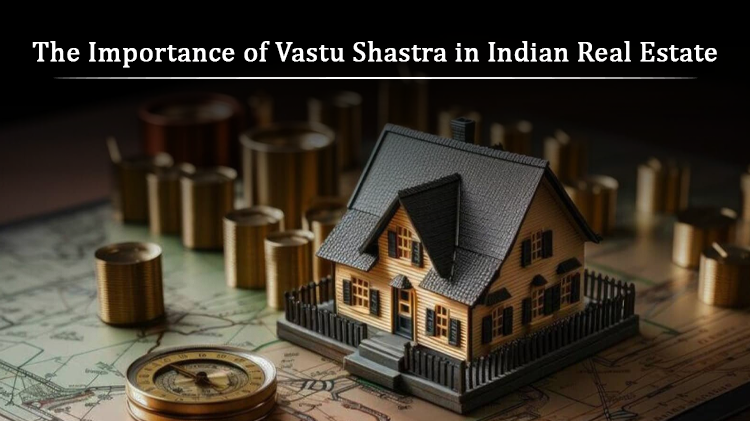
Vastu Shastra, an ancient Indian discipline of building and spatial planning, has been an important part of Indian culture for thousands of years.
In recent years, its influence has grown tremendously in the real estate sector, shaping the way homes, offices, and commercial spaces are designed and valued. This blog explores the depth of Vastu Shastra’s importance in indian Real Estate, its impact on buyers and developers, examining its principles and why it continues to hold such significance in the modern property market.
Understanding Vastu Shastra
Vastu shastra translates to the science of architecture. Rooted in traditional Hindu and Buddhist philosophies, it provides a comprehensive set of guidelines for designing and constructing buildings in harmony with the natural world. The core idea is to align structures with cosmic energies, ensuring that the spaces we inhabit foster well-being, happiness, and prosperity.
Vastu Shastra incorporates the five elements, like earth, water, fire, air, and space, into the design process. It prescribes the ideal orientation, layout, and placement of various rooms and features within a building to maximize positive energy flow and minimize negative influences.
Why Vastu Shastra Matters in Real Estate
1. Positive Energy and Well-Being
One of the primary reasons Vastu Shastra is so valued in real estate is its focus on creating spaces that radiate positive energy. By carefully considering the orientation and arrangement of rooms, windows, doors, and even furniture. Vastu aims to ensure a balanced and harmonious environment. This, in turn, is believed to promote good health, mental peace, and emotional stability for the occupants.
2. Financial Prosperity and Success
Properties that adhere to Vastu are frequently linked to wealth and financial riches.
For example, placing the main entrance in the northeast is thought to attract positive cosmic energy, leading to increased opportunities and success in business or personal life. Many buyers and investors are willing to pay a premium for Vastu-compliant properties, seeing them as auspicious investments that can yield long-term benefits.
3. Higher Property Value and Market Demand
Vastu-designed properties are frequently more valuable on the market. Demand for Vastu-compliant residences and workplaces has increased, particularly among Indian purchasers who view these ideas as necessary for a peaceful existence. Developers who incorporate Vastu guidelines into their projects can attract a broader customer base and enjoy a competitive edge in the market.
4. Enhanced Aesthetics and Functionality
Neither practicality nor beauty is sacrificed in Vastu Shastra. Its guidelines often result in visually appealing and highly functional spaces. The emphasis on neutral light, balanced layouts, and ventilation creates environments that are both beautiful and practical to live in.
5. Psychological and Emotional Benefits
Living in a Vastu-compliant home can help in reducing stress and anxiety by creating a balanced environment. Many homeowners find Vastu to be a desired feature because of the sense of harmony and order it provides, which can promote emotional stability and peace of mind.
Vastu Shastra and Property Valuation
Its impact on property valuation is significant. Properties that adhere to its principles are perceived as more desirable, leading to increased demand and higher prices. Here’s how Vastu influences real estate value:
Vastu Factor Impact on Property Value |
|
|---|---|
|
Positive Energy |
Attracts more buyers, increases demand. |
|
Balanced Layout |
Enhances functionality and appeal, raises perceived value. |
|
Nautal Light & Ventilation |
Promotes health, reduces utility costs. |
|
Aesthetic Interiors |
Increases visual appeal, adds to marketability. |
|
Curb Appeal |
Well-maintained exteriors attract premium buyers. |
|
Long-Term Benefits |
Consumers are willing to pay more for sustained success. |
Core Principles of Vastu Shastra in Real Estate
A. Plot Selection and Orientation
-
Shape and Slope: Plots that are square or rectangular are said to be the most auspicious since they represent balance and stability. Land sloping towards the north or east is preferred, as it is believed to facilitate the flow of positive energy.
-
Surroundings: Proximity to clean water bodies, open spaces, and greenery is considered beneficial, while clutter is to be avoided.
B. Layout and Room Placement
-
Entrances: The main entrance is regarded as the gateway for energy. To attract wealth and good vibes, it should ideally be in the north, east, or northeast.
-
Living Room: Placing the living room in the northeast or north encourages social interaction and positive energy.
-
Bedrooms: For master bedrooms, southwest is thought to be the best option because it promotes stability and sound sleep. Children’s rooms are often placed in the west or northwest.
-
Kitchen: It aligns with the fire element and ensures health and abundance. The Southeast is the ideal place for kitchens.
C. Natural Elements and Energy Flow
-
Light and ventilation: Vastu emphasizes the importance of natural lighting and cross-ventilation, which not only improve health but also reduce energy consumption.
-
Sustainability: Country yards, gardens, and balconies are encouraged, as they enhance the flow of energy and provide a connection with nature.
D. Interior Design and Aesthetics
Colors and Materials: In order to create a calm and well-balanced atmosphere, soft, natural colors and materials are preferred.
Decor: Vastu guides the placement of water, plants, and mirrors to amplify positive energy and minimize negativity.




3 Comments